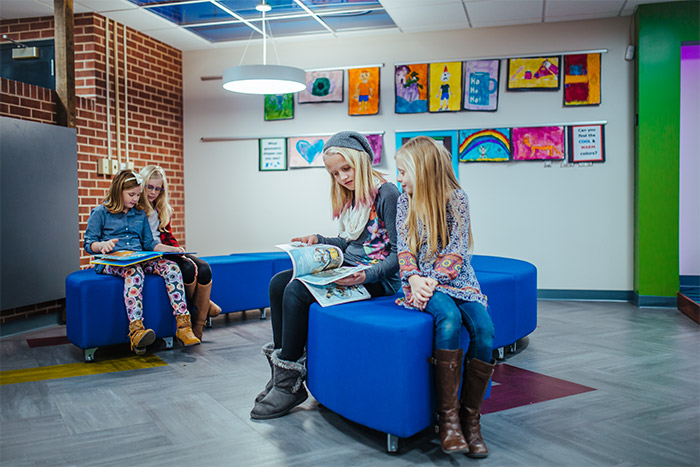Designing Learning Spaces for All Students
Here are some design considerations previously reserved for children with IEPs that are now being incorporated throughout all areas of public schools:
Here are some design considerations previously reserved for children with IEPs that are now being incorporated throughout all areas of public schools:

Years ago, it was common to separate K-12 students with special learning requirements from the rest of the student body. Instead of being integrated into the school, students enrolled in special education were often disconnected from other students, taught in isolated rooms designed to support their specific needs.
An increasing number of children in need of individualized education plans (IEPs) are now joining their peers in regular classrooms. Policies of separation and isolation are being replaced with those of mainstreaming and inclusion. While this shift has the benefits of improved academic performance, socialization and self-esteem, it does pose challenges.
With integration comes the need for support from aides, a variety of spaces to accommodate different learning styles, and design considerations traditionally only found in special education rooms. They may not be able to participate in every class, but designing general classrooms to support students with special learning requirements allows them to join their peers whenever possible. This benefits all students as they learn to interact with one another, develop empathy, and discover ways to positively integrate into the classroom and the world.
Specialty design previously incorporated into isolated classrooms actually benefits all students – not just those in special education or talented and gifted programs. Here are some design considerations previously reserved for children with IEPs that are now being incorporated throughout all areas of public schools:
Classrooms are being redesigned for improved flexibility to accommodate different learning styles. This goes beyond wider doorways and desks that allow wheelchair accessibility.
Movable furniture and partitions help students come together as a large group, break into small groups, or engage in one-on-one, distraction-free learning. A reconfigurable classroom lets students receive different levels of instruction within one space to improve feelings of inclusion for those with special needs, as well as for students in talented and gifted programs.
Flexible classroom designs also allow teachers and paraprofessionals to move around easily and create pathways so they can walk to each student’s desk without obstruction.
Studies show that children with autism suffer from headaches and behavioral issues induced by fluorescent lighting (due to humming and flickering) – but this problem isn’t reserved for students with special needs. Kids at all learning levels can suffer from these types of headaches.
Instead of using fluorescent lighting in classrooms, hallways, and cafeterias, consider an alternative. Possible solutions may include light filters, which reduce flickering and harsh lighting levels, or retrofitting lighting fixtures with LEDs.
Innovation in lighting design is taking it beyond intensity and color tone. When you combine these typical lighting attributes with the natural patterns of the human body, the way it reacts to daylighting and the emotion that lighting and color can draw from people, you start to create a new learning environment. SchoolVision, developed by Phillips, lets teachers choose between different settings; normal, focus, energy, and calm to improve the performance of the task at hand.
Children with mental, physical, and behavioral disabilities and disorders may require a very specific balance of color and visual stimulation so wall décor isn’t distracting; however, overstimulation due to color, clutter, and furniture can distract all types of students.
Simple, uncluttered environments are appropriate for most children. Consider creating a standard that teachers can follow when it comes to appropriately decorating walls and bulletin boards. Select just a few calming colors to use on walls and floors throughout classrooms.
Noise is a significant distraction in school settings. Whether loud, abrupt, barely audible, or constant, noise proves to make students pause or stop entirely. Many design considerations can be incorporated to minimize sound distractions.
The doors can have sound seals and the demising walls can have a high level of sound attenuation to prevent noise from adjacent classrooms and corridors. Inclusion of sound attenuators and silencers in mechanical systems can further reduce ambient noise. White noise can be used to decrease the barely audible sensory noise.
Abrupt bells and tones broadcast throughout the school to indicate class changes can also disrupt and alarm children with special education needs. However, these sounds are often alarming for children in general. Sound absorbing materials in the room, such as fabric faced bulletin boards and carpet, reduce noise and limit the echo of loud noises. Configuration of the space can accommodate for proper reverberation times, allowing speech to be understood at conversational levels. By reducing volume and making sound less intrusive, unnecessary stress can be avoided.
Inclusive classrooms incorporate flexibility, adaptability, predictability, and controllability to support students at all stages of learning. By moving these considerations of specialty design into all areas of public schools, all students benefit – not just those in special education.